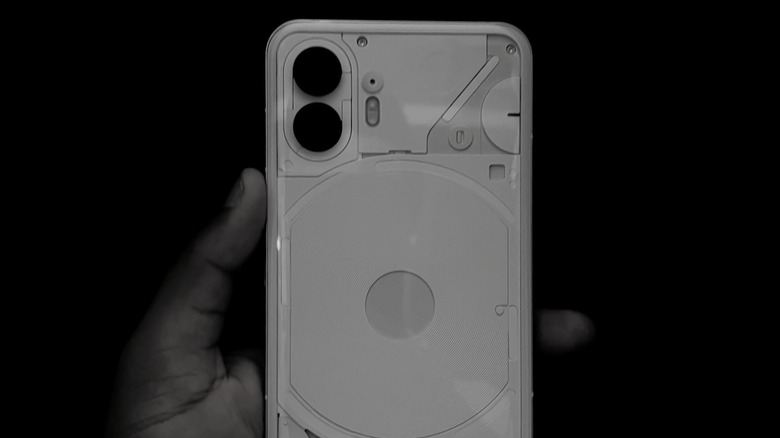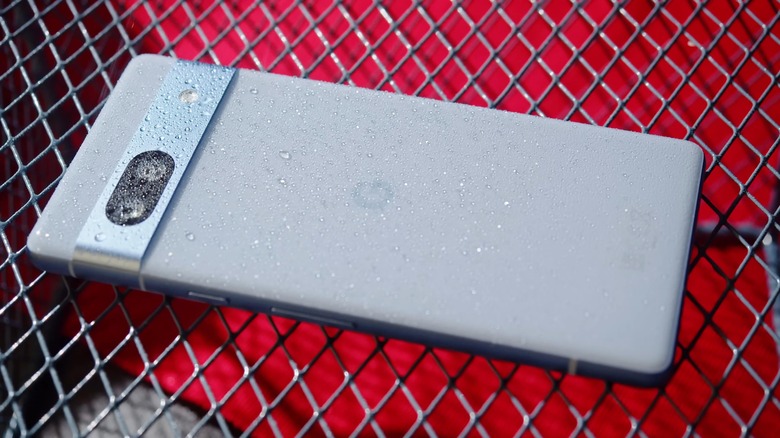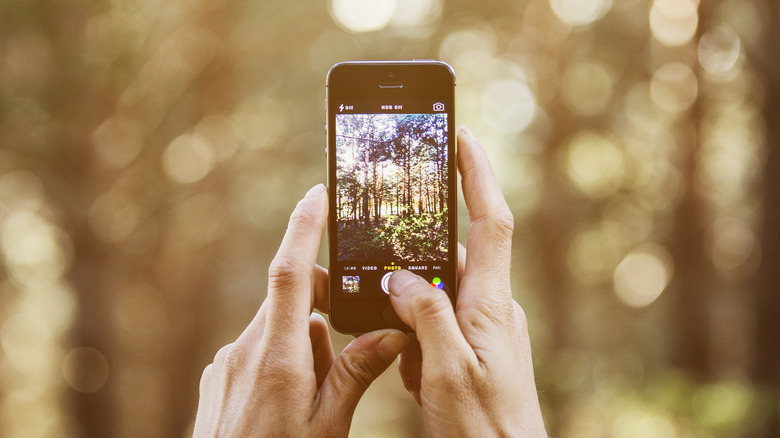The Top Android Phones For People Who Love To Take Photos
It's not exactly a breeze picking up a phone with the key objective of clicking pictures. Memories are precious, after all, and you don't want them to look fuzzy or comically color-corrected. Each smartphone maker serves their distinct flavor of photography on their smartphones, with a set of features that can either be downright gimmicky or exclusively game-changer. Then comes the cost consideration, which is important and works both ways.
Buyers often end up dropping some serious cash on a phone when all they need is a reliable camera shooter that gets the basics right, which a mid-range Google Pixel phone can pull off with ease. But obsessing too much over camera hardware, flashy tricks, and photography essentials can quickly push you down a rabbit hole.
What follows is a list of Android phones across different price brackets that have carved a solid reputation for clicking great photos without overwhelming a person with complex settings. The SlashGear staff has thoroughly tested all the phones listed below. Details about their camera performance, merits, and shortcomings have been described after testing them in different scenarios.
Google Pixel 8 Pro
Google's Pixel series phones have made a name for themselves for delivering crisp photos with an impressive level of control over color accuracy and augmenting the final output with clever use of camera tricks such as multi-stage computational segmentation. For years, Google stuck with a low-resolution sensor but lifted it using software tricks that put these phones right at the summit. With the Pixel 8 Pro, Google's software wizardry is at full display once again, but this time around, the company picked up a pair of 48-megapixel zoom and ultra wide-angle sensors alongside a 50-megapixel primary snapper to scale new heights.
Google's strategy of boosting the camera hardware has yielded positive results. SlashGear's review of the Pixel 8 Pro notes that the Pixel 8 Pro "delivers a photography experience that makes it difficult to take a bad shot." Stills turn out consistently well, with impressive dynamic range. But Google ships a handful of exclusive features with its latest Pixel flagship that set it apart from the crowd. For example, the Face Unblur feature combines the data from the primary and ultra-wide snappers to sharpen details, such as facial textures, if there was a movement during the capture that led to blurry face or fuzzy details.
One of the most well-known tricks is the Magic Eraser, which performs impressively at removing unwanted objects from an image. Google has now added another dimension to it by allowing users to even remove unwanted audio artifacts from videos. Then there's the new Zoom Enhance system, which aims to solve one of the biggest pain points with long-range digital zoom shots. Using generative AI, somewhat like Dall-E, it will perform pixel-level upscaling in the focus area of a zoom picture, resulting in a sharper, more detailed picture.
Samsung Galaxy S23 Ultra
Samsung's Galaxy S series flagships have never been shy of making hardware leaps when it comes to their imaging capabilities. Credited with pushing multiple camera breakthroughs into the mainstream, the Galaxy S23 Ultra is no exception to that legacy. It offers a powerful 200-megapixel primary camera that can change the output size and quality based on your preference, thanks to a technique called pixel-binning that creates a square array of combined pixels to create a larger super-pixel, one that is capable of processing more light data and delivering more detailed shots. Samsung has traditionally sided with a slight artificial boost to the final image, which makes the final image look a bit more saturated and punchier.
As a result, the final image looks more pleasing to the eyes. But that doesn't take away from the fact that the Galaxy S23 Ultra produces some of the most stunning photos and videos you will come across from a phone. It is also one of the most reliable phones for capturing low-light shots, all thanks to the massive camera sensor and the inherent pixel-binning tech that produces well-lit shots even in extremely dark environments.
Samsung's camera app is also loaded with a ton of features, such as the excellent Director's View for simultaneous capture from each sensor and Astro Hyperlapse. If you seek more pro-grade controls, the Expert RAW app will give you more than that. But it's the zoom output that really sets the phone apart. The 10-megapixel periscope-style zoom camera at the back delivers an unparalleled 10x lossless optical zoom range. Thankfully, pictures clicked at the 100x digital zoom range aren't an indiscernible mess and offer a healthy improvement lead over any of its competitors.
Google Pixel 8
One of the biggest differences between the Pixel 8 and its Pro variant is the absence of a dedicated telephoto camera. If you are not concerned with long-range zoom photography, you can comfortably put your faith in the Pixel 8 and save a few hundred dollars while at it. The Pixel 8 offers a 50-megapixel primary snapper and a 12-megapixel ultra wide-angle camera, both of which produce great results. "Pixel 8's main camera does provide extremely good performance in low light, and overall image quality is extraordinary," says SlashGear's Pixel 8 review.
One of the biggest strengths of the Pixel 8 is the accurate reproduction of natural skin tones, a trick Google has been trying to master for years, to impressive results. The photos and videos captured by the Pixel 8 exhibit a wide dynamic range, ample saturation, and impressive control over contrast levels. Interestingly, the team over at Google has also improved the stabilization output, which shows its might at capturing photos and videos on the move.
Low-light capture is another strong suit of the Pixel 8, thanks to the larger camera sensor and the Pixel's consistently reliable computational tricks. The phone, which currently starts at $699, also counts portrait photography as one of its fortes, offering one of the most accurate subject separation and natural bokeh effects you can get from a phone. Moreover, being a Pixel phone, the feature drops and exclusive tricks in the Google camera app will only add to its capabilities over time.
Nothing Phone 2
The second phone from the London-based upstart grabs eyeballs for its flashy design, but its camera performance is anything but. For folks that dream of a high-resolution imaging sensor for ultrawide capture that is in the same league as the primary camera, the Phone 2 serves just that with its 50-megapixel rear snapper two. The two cameras capture detailed photos in daylight with adequate sharpness and a vivid color profile without any eyesore post-processing done to the images. "Portrait mode is one of the better ones you'll find on a smartphone camera," adds SlashGear's review of the Nothing Phone 2.
In general, the Nothing smartphone leans more towards capturing photos with a warmer color profile compared to Google's Pixel phones, but there's plenty of detail in the pixel-binned photos it captures by default. Where it falters compared to the competition is portrait capture, as edge detection is not as detailed as one would expect from a high-resolution sensor, and the bokeh effect is also pretty flat, with little depth to the blurred surroundings. Another chink in the phone's armor is low-light capture, where the phone could use more tuning and better algorithms to reduce noise and be less aggressive with the scene sharpening. Thankfully, Nothing has improved the camera output in some crucial areas with software updates over the past few months.
Google Pixel 7a
Priced at a fraction of heavyweights like the Samsung Galaxy S23 Ultra, the Google Pixel 8 Pro, and Apple's latest iPhone 15 Pro pair, the Pixel 7a is one of the most reliable camera phones for its price out there. In fact, Google armed it with a more powerful 64-megapixel primary camera than the far more expensive Pixel 8 series flagships. SlashGear's review of the Pixel 7a notes that "it's difficult to take a truly terrible photo, and easier than you might expect to capture something decent." The phone excels at reproducing the natural colors in the frame with impressive white balance and exposure control, as well as accurate subject separation. Night mode is impressive, as usual, and it can often reproduce shots that put top-tier flagship phones to shame.
Another strength of the Pixel 7a is depth estimation, allowing the phone to capture portraits with a natural bokeh effect and great subject separation. It helps that the autofocus lock is quick and accurate. It's also worth noting that unlike a healthy bunch of mid-range phones out there, there is minimal color disparity between images captured by the primary or the ultra wide-angle cameras, and there is little edge distortion to be seen.
It struggles with handling noise artifacts and keeping the focus locked in challenging light scenarios or with moving subjects, but it's not a deal-breaker when you put the overall output into context. And being a Pixel phone, it also gets access to a bunch of exclusive editing features in the Google Camera and Photos apps, such as Motion Mode and Top Shot, among others.
Some extra tips
Before you decide to splurge on a phone for its photography chops, a few aspects are worth considering. Google's Pixel phones don't do much in terms of color-centric post-processing as they bank more on the side of true-to-life capture. If you are not well-versed with color adjustments as you shift the focus from light to dark areas, the final image might look a tad less saturated. On the other hand, the likes of Samsung and most other Chinese brands tend to oversaturate photos to deliver a more vivid color profile, which may be not accurate but looks pleasing to the eyes and serves as a more suitable pick for posting on social media. It's a subtle difference but one that really matters.
It's worth keeping in mind that camera capabilities are not solely dependent on the sensor fitted inside a phone. A lot of it depends on the image signal processor and the processor powering the push phone. Take, for example, the Pixel 8 series phones, which take advantage of the new Tensor G3 processor to serve tricks like night capture support in time-lapse mode and video boost for Night Sight. With that status quo in place, it's worth checking out a generation older or even a two-year-old Android flagship, as they offer a solid combination of powerful cameras, top-tier processors, and an assurance of long-term software support.
With that consideration in mind, you can pick older-generation flagships, such as the Samsung Galaxy S22 Ultra or the Pixel 7 Pro, and save some serious cash while at it. The generation-over-generation upgrades are usually subtle, so you can safely pick a year-old flagship without the risk of missing out on too many meaningful tricks. Just make sure that you choose one with a large battery inside.
How we test phones
All the phones listed above have been tested by SlashGear's team, which comprises experts with over a decade of experience testing smartphones from all major brands across every price bracket. When it comes to camera testing, we start with standalone testing of a phone to see its merits and shortcomings. The results are compared with the predecessors to see if they bring any notable upgrades, especially in their imaging capabilities. The photos and videos produced by the devices being reviewed are also compared against other competing phones in the same price bracket to see whether they offer any notable edge or fall flat against the rivals.
As far as the tests go, each camera — primary, ultrawide, and telephoto zoom — is tested on its own with the same standalone and comparative protocols mentioned above. We begin the camera tests with shots clicked under daylight, assessing parameters such as dynamic range, color accuracy, exposure, and shadow control. At this juncture, the shots clicked from the primary and ultrawide sensors are also compared side-by-side to check for any color disparity and signs of edge distortion.
Under low light, we separately test the outputs from the dedicated night mode, emphasizing how it brings out colors in challenging conditions, suppresses noise, and keeps grainy textures under control. Low-light camera testing often proves to be a litmus test for a smartphone's camera capabilities, and we make sure to assess it thoroughly to check how capable the cameras are and whether the underlying imaging algorithms can produce usable results. We also extensively check the results from any special features offered by manufacturers to discern whether they add to the photography experience or fall flat as just another gimmick.







